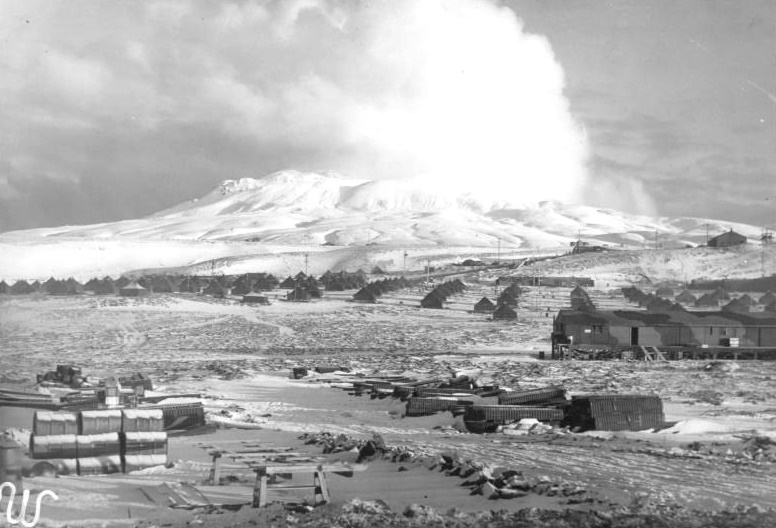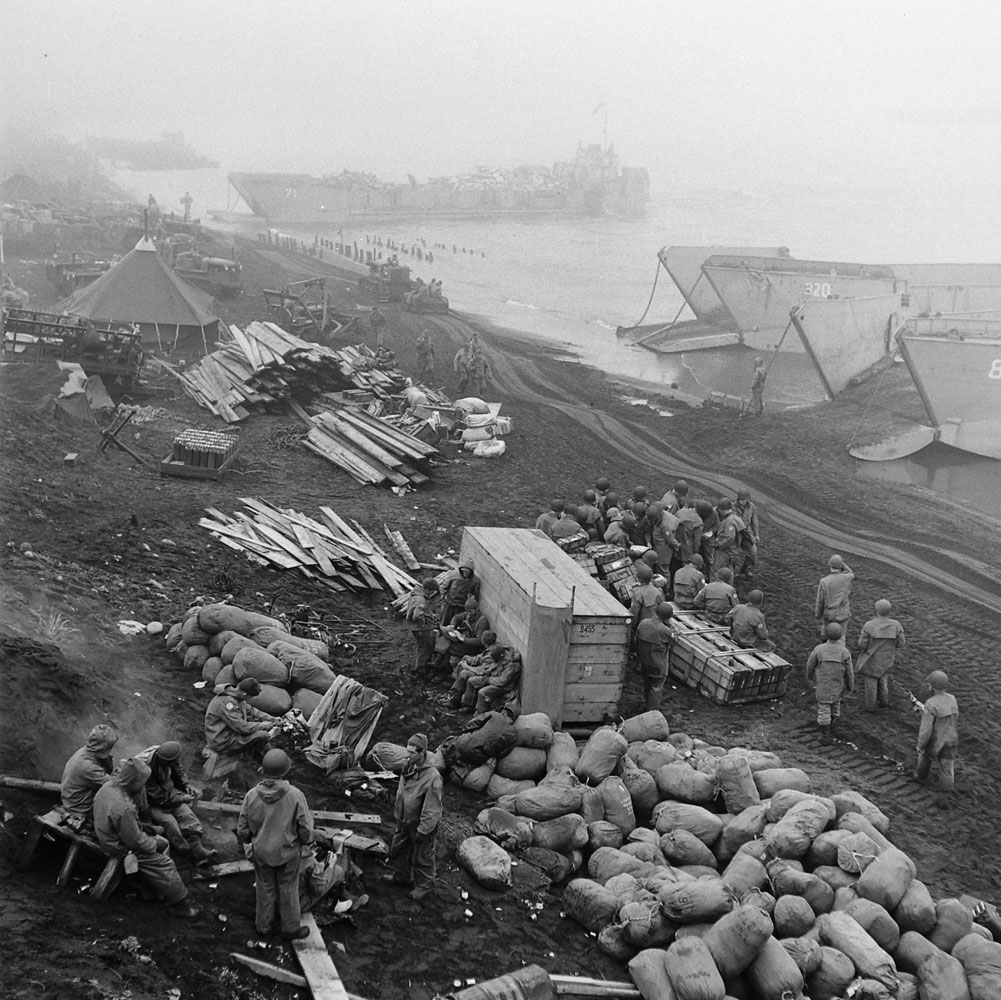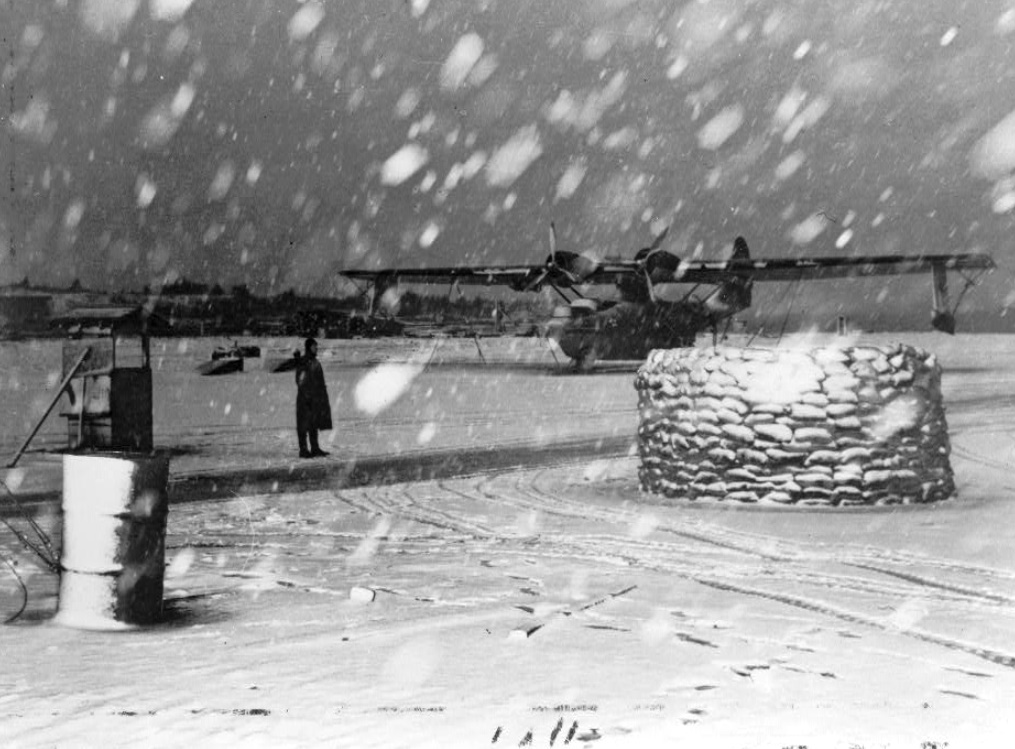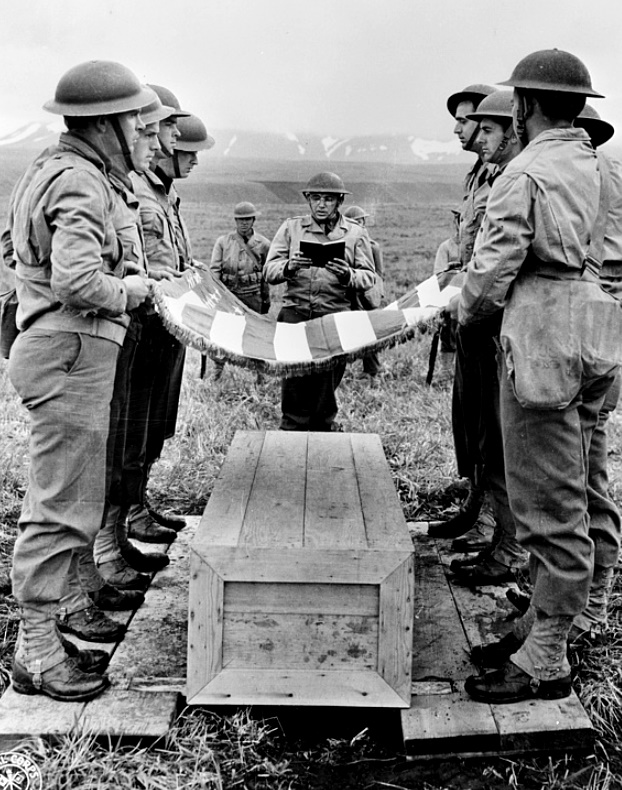Gen Buckner had been pressing Adm Theobald to take some action against the Japanese in the Aleutians besides the ineffectual bombing, though Theobald had rejected what he considered to be rash appeals. He did attempt to bring naval power to bear on the enemy by shelling Kiska. Theobald led a fleet of four cruisers and nine destroyers out of Kodiak on July 18 1942, with the object to harass Kiska. The fleet ran into bad weather, and four of his ships collided in the fog. Theobald returned to base in August without having fired a shot. Theobald was upbraided for leaving his headquarters and turned the tactical command of his vessels over to RAdm William W. Smith with orders to try Kiska again.
On August 7, Smith’s forces bombarded Kiska with high explosives for seven minutes with little effect. The Army had ordered a recon to find a suitable site for an airfield within effective striking distance of Kiska. Over the summer, Col Talley had made two trips, choosing Tanaga, 200 miles east of Kiska, as the optimal location for an airfield. DeWitt proposed the occupation of Tanaga, but Theobald countered that Adak, 50 miles east of Tanaga, should be the site. The decision went to the Joint Chiefs of Staff for resolution. Tanaga was initially confirmed, but Theobald argued that there was no harbor at Tanaga, while Adak possessed natural harbors as well as flat ground for an airfield. The Joint Chiefs finally supported the Navy’s position, whereupon the Army grudgingly agreed to Adak as the only way to get action out of Theobald. It was during this period of Army-Navy tension that Buckner read a poem in the officers’ club at Kodiak which satirized Theobald’s cautious nature. Theobald protested to Adm King, who took up the matter with Gen Marshall. Buckner narrowly escaped being transferred out of Alaska as a troublemaker, though just who saved him is subject to dispute. On August 17, 1942, a Congressional investigation committee led by Senator Albert B. Chandler, chairman of the Military Affairs sub-committee, visited Dutch Harbor and Kodiak. It happened to be sunny that day, and Chandler came back scoffing about the problem of fog and weather in the Aleutians. He also, however, recommended a unity of command for Alaska and that the territory be given more authority and Alaska more personnel and supplies. Little came of the visit. Another incident occurring on August 30, 1942, was the sinking of the seaplane tender Casco by a Japanese submarine, the RO-61, in Nazan Bay, Atka. The Casco was salvaged and repaired afterward, while PBYs and the USS Reid sank the submarine, capturing five prisoners, the first Japanese prisoners of war in Alaska.
What was known as the Umnak Dispersal, the occupation of Adak (the island itself was codenamed Fireplace) began August 26, 1942, with the landing of Castner’s Alaska Scouts to check for enemy forces. None were present, and on August 30 a force of 4500, led by Gen Eugene M. Landrum, began landing. The primary reason for a base at Adak was the construction of an airfield, which the Army had anticipated would take two to three months.
However, a survey of Sweeper Cove suggested that a field could be built on the tidal flats with minimal surface preparation if a dike were constructed to control the tidal flow. A field was operational within two weeks after the initial landing. On Sept 16, 1942, a force occupied Atka, east of Adak, and began building an emergency landing strip and establishing a small garrison. While Adak became the largest base among the Aleutians, Atka suffered neglect. Supplies destined for Atka were transshipped at Adak and never arrived. The scarcity of supplies and transport in the Aleutians led to pilferage, unofficial requisition, and the motto, God helps those who help themselves. An airfield was also established on St Paul in the Pribilofs, but that base was soon abandoned. The move to Adak points up the changes in construction which had come full circle since the initial phases of the buildup. The construction of mobilization buildings, permanent structures with wood framing requiring skilled building trades labor to erect, and permanent barracks involving reinforced concrete and steel such as had been put up at Ladd Field, Fort Richardson, Sitka, Kodiak, Dutch Harbor, and Seward was a thing of the past. Beginning in December 1941, the military had begun to requisition prefabricated shelter types which were quicker and easier to erect. CCC-type buildings – prefabricated sectional wood panels with tarpaper roofs and drop siding – and theater of operations (T/0) buildings – prefabricated structures in standard 20-foot widths with sectional extensions up to 120 feet long – were still set up at larger bases, mostly in the rear echelons, but most new construction was modular in nature. The first housing that many troops saw were Army winterized tents. These were 16×16 foot canvas duck pyramidal tents with a wooden floor and sides and frame designed to accommodate a central Sibley coal stove. These structures were barely adequate and tended to blow down in Alaska’s high winds, yet they did provide minimal housing for troops while other structures were being put up.
The main types of modular buildings used in Alaska were the Quonset and Pacific Huts. The former, designed by the Navy, consisted of a half-cylinder profile structure with a steel frame and corrugated sheet steel siding; there was essentially no foundation, and the wooden flooring was designed to rest at grade on a light framework. Composition board insulation and interior finishing were provided. Quonsets were designed in either 16×36 or 24×60 foot modular units (the larger size was equipped with gabled windows). They are said to have an air and water gap between the roof and end joints and use almost 100% strategic materials (steel). The Pacific Hut was the Army’s answer: a sectional hut in 16×36 foot units, consisting of laminated plywood (Masonite) sides on an arched steel frame, using only 7 percent strategic materials with the rest common wood products found in the Pacific Northwest, where the huts were manufactured. The Pacific Huts were cheaper, lighter, and easier to set up, but seem to be less durable once erected. Both types, especially Quonsets, were commonly dug in so that the roofline was near ground level.
The excavated earth was either revetted around the structure or actually packed in around it. This was to present a lower profile for wind and as protection from enemy ordnance damage and/or insulation. A further variation on the same theme was the Jamesway Hut, a 16-foot wide hemispherical structure in eight-foot lengths with a wooden floor and a laminated hoop frame designed to be covered by rubberized canvas. The Butler building and British Nissen Hut were similar building types, references to which also occur in the literature about Alaska in World War II. Utility structures used in the Alaska theater include the Yakutat Hut, a wooden frame modular structure with prefabricated wall sections in 16×16 foot units, described as a shack that could double as a chicken coop, and the Stout House, a 12×16 foot box with composition board panels. The Stran Steel Hut was also used; it came in 20×48 and 40×100 foot units (Bush 1944; USN 1952). Many of these structures came prepackaged with all necessary sections, hardware, fittings, and wiring, though package units often arrived in a scavenged state with critical parts missing. There was also general agreement in Alaska that the Navy was better at plumbing, while the Army was better at the wiring. The interservice rivalry was often breached by low-level pacts to fix up the other’s quarters with the specialty of the house.
Warehouses, mess halls, repair shops and other non-housing structures included many of the same types, but on a larger scale. Reinforced concrete and mobilization style (60×153 feet standard wood frame construction) were restricted to the early buildup bases, though once a base had become established, it tended to acquire more elaborate public architecture, like T/O buildings (standard – 20 feet wide by 60-180 feet long – and heavy – 50 feet wide by 150-180 feet long wood frame and prefabricated tarpaper siding) and CCC buildings (knockdown portable, prefabricated panel construction). Loxstave buildings (prefabricated wooden structures with an interlocking log cabin corner joint), transit shed type structures (timber frame set in a concrete slab foundation, usually 181×400 feet), and various elephant Quonset and Butler Hut structures were the most common. The Cowin Hut was used but discontinued in 1943 as inadequate. Cold storage used liquid freon, except for ammonia units at Fort Richardson and Ladd Field.
Modifications had to be made to take the harsh conditions into account. After the initial battles with headquarters in Seattle, there was more freedom and local authority in construction, and gradually standard structure design became more responsive to local needs. There was little concrete work, including foundations, at forward bases. One reason was the difficulty of construction on permafrost and tundra, which afforded little in the way of a stable foundation. Even “floating” on-grade construction could be damaged by frost heaves. Vestibules had to be added where there was a need for a cold lock (a feature known to Eskimo builders) and/or a drying area where outer clothing could be removed and dried. The thicknesses of structural members had to be increased, additional bracing put in, diagonal sheathings applied and the distance between studs narrowed to reduce the possibility of damage from the wind.
Wooden or other siding had to be added to protect the usual tarpaper siding from being torn off by the wind. Vapor barriers were needed to prevent rot from high humidity. Air exhaust units and special chimney caps were also needed to prevent fires. The difficulties inherent in living under these primitive conditions in Alaska could lead to a lack of shelter in sub-zero weather. For example, in January 1943, warehouses at Yakutat collapsed under 27 inches of snow, and there were 17 major fires reported between November 1942, and January 1943. Special modifications of equipment were also required to undertake construction. The workhorse of the theater was the Caterpillar tractor. Models D4, D6, and D7 were used as small dozers and to pull trains, while the larger D8s and RD8s were heavy construction dozers and traction units. They could be mounted with bulldozer (straight/angled) and scraper blades and with traction hitches for trailers or cable plows, among other uses. International (the TD series) and Allis-Chalmers tractors were also used but were less common. The Snog (TU3 and LTR) was also used for plowing and traction. The cats primarily pulled the Athey trailer, a tread-mounted platform that could be loaded with cargo or converted to a bin-and-dump carrier, though various types of skids and sleds were devised where even tracked as opposed to wheeled vehicles were impractical.
Also of importance was the adaptation of an Alaskan innovation, the wanigan, a skid-mounted platform with sides and a roof used for storage, housing, and workspace. These were the most versatile vehicles in most of Alaska, though even they had a tendency to bog down in tundra, and the tracks churned up the muskeg so that no unprepared road could be used efficiently for very long. In the Aleutians, the surface and the terrain were such that often the winch units had to be anchored and the cats walked up or down slopes using these attachments rather than primary motive power.
Carryall scrapers -tracked creepers with a scraper blade and conveyor arrangement that dumped the excavated spoil into a bin- made by LeTourneau and Woodbridge were used at larger construction sites, as were power shovel/ dragline units. These were made by Bucyrus-Erie, Northwest, and Lima, and required Alaskan modifications involving special undercarriages, longer track frames, and wider treads. Among wheeled vehicles, the workhorse was the 2 1/2 ton (Deuce-and-Half) platform truck, used for general transport. Models made by Chevrolet, Ford, International, and GMC were used. This vehicle could also be converted to a dump truck model, though a variety of specialized dump trucks were also used, including Euclid all-wheel-drive 10 and 20-cubic-yard dumpsters. Again modifications, such as heavier frames and springs, were required since transport needs often exceeded rated loads. Caterpillar, Austin, Western, and Galion graders were also used. The Jeep, among other small transport and staff vehicles, was used as well. There were an estimated 5000-10.000 vehicles in use in Alaska during World War II, providing a wide variety of uses and problems.
With all these various vehicles, most of which were operated abusively under harsh conditions, maintenance was a problem. There was a constant shortage of spare and replacement parts as well as tools and trained mechanics. The repair was laborious in a climate where fingers would freeze to metal and gasoline could freeze in fuel lines, especially when proper facilities were lacking. Mobil shop packages and vehicles were set up to be taken from site to site as needed, but these were inadequate. Permanent repair shops were established at Ladd Field, Fort Richardson, Annette Island, Yakutat, Excursion Inlet, Sitka, Kodiak, and Dutch Harbor.
Fort Glenn served as the forward repair base facility for the Aleutians until Adak was well established. Later, facilities were set up in Amchitka, Attu, and Shemya. Since one of the primary purposes of the military presence in Alaska was to support aerial activity, aircraft facilities were important. It was virtually impossible to house aircraft under cover or even to work on them inside. A variety of structures and techniques were used and devised to cope with these problems. At the lowest level were exhaust preheaters, devices consisting of rubberized canvas sleeves designed to fit over the engines of planes and attached to a heater which were used to bring the engines to cranking temperature. Temporary nose hangars, consisting of a pipe and wood frame covered with canvas to field shelter repairs, were also developed. Mobile shop trailers were used to bring the tools to the aircraft, rather than queuing up the aircraft for limited shop facilities. Permanent Base/Operations hangars were built at Fort Richardson (270×270 feet) and Ladd Field (271×327 feet) using steel arches set in a concrete slab floor. Yakutat temporary steel hangars with modular frames and siding (120×220 feet) plus lean-to shops arranged along the side were developed, as were TBA (Butler Manufacturing Company) knockdown modular steel truss hangars with 130×160 foot dimensions. Birchwood hangars, with 150-foot bowstring trusses on timber columns with 25-foot lean-to shops of a dimension of 202×300 feet, were built, as were T or Kodiak hangars of all wood bowstring or Howe trusses in 129×47 foot and 40×55 foot sizes. Seaplane facilities, including buoys, ramps, parking hardstands, and nose hangars were also constructed at various bases.
The Navy bases had been built largely by civilian contractors of the Siems-Drake-Puget Sound coventure, but after the bombing of Dutch Harbor, contract labor was phased out by the Navy. The Seabees took over by July 1942, but these construction troops mainly worked in the forward bases in the Aleutians. The last Siems-Drake-Puget Sound workers left by February 1943, though the Army would step up the issuance of civilian contracts. The Navy meanwhile opened up new installations at a cannery at Sand Point and at Chirikof Island, southwest of Kodiak. The Eleventh Air Force began bombing runs against Kiska, covered for the first time by fighter support, from Adak on September 14, 1942. The closeness of the new base allowed the Air Force to step up its attacks. During the fall, the Japanese lost at least 34 planes, including one to the RCAF (which had moved a squadron of Kittyhawks out to Adak), plus eight probable kills, while the US lost ten planes in combat (mainly to antiaircraft fire) and 63 to weather and mechanical problems.
 The Japanese, who had initially planned to hold Attu and Kiska only until winter, were now convinced that the US was going to invade Kiska. On August 24, the Japanese began evacuating Attu to concentrate all their forces on Kiska, a move completed by mid-September, 1942. In October, the Japanese North Pacific command was reorganized. The Kuriles were reinforced, Attu was reoccupied by 1000 troops, and Kiska was reinforced to a strength level of 4000. Meanwhile, the Navy recalled most of Theobald’s vessels from Alaska to support the campaign at Guadalcanal where, incidentally, the Japanese carrier Ryujo, which had attacked Dutch Harbor, was sunk in August, 1942. Thereafter any further aggressive activity in the Aleutians was put on hold for the winter and pending the availability of forces.
The Japanese, who had initially planned to hold Attu and Kiska only until winter, were now convinced that the US was going to invade Kiska. On August 24, the Japanese began evacuating Attu to concentrate all their forces on Kiska, a move completed by mid-September, 1942. In October, the Japanese North Pacific command was reorganized. The Kuriles were reinforced, Attu was reoccupied by 1000 troops, and Kiska was reinforced to a strength level of 4000. Meanwhile, the Navy recalled most of Theobald’s vessels from Alaska to support the campaign at Guadalcanal where, incidentally, the Japanese carrier Ryujo, which had attacked Dutch Harbor, was sunk in August, 1942. Thereafter any further aggressive activity in the Aleutians was put on hold for the winter and pending the availability of forces.


























